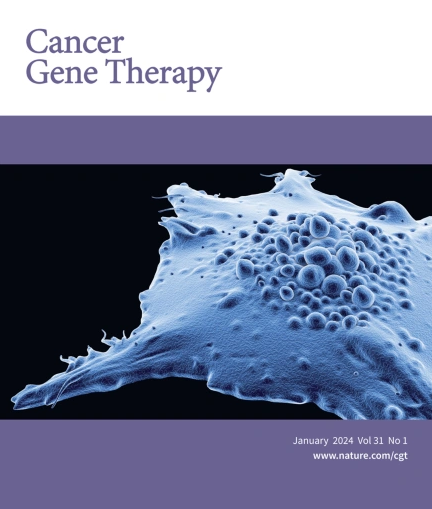铁下垂增强溶瘤腺病毒KD01对癌症的治疗潜力。
IF 5
3区 医学
Q1 BIOTECHNOLOGY & APPLIED MICROBIOLOGY
引用次数: 0
摘要
通过选择性靶向和裂解肿瘤细胞,溶瘤病毒疗法已成为一种很有前途的癌症治疗策略。然而,由于多种因素,其疗效在某些肿瘤类型中往往受到限制。本研究探讨了溶瘤腺病毒与强效铁凋亡诱导剂Erastin的联合作用,以增强对溶瘤病毒不敏感的癌细胞系的抗肿瘤效果。体外实验表明,与单一疗法相比,Erastin显著增加了溶瘤病毒疗法的细胞毒性,导致更大的细胞增殖抑制和细胞死亡率升高。联合治疗进一步促进了铁下垂,证据是活性氧(ROS)水平增加,脂质过氧化增强,氧化还原稳态被破坏。RNA测序发现Dickkopf-1 (DKK1)的下调是增强铁效的关键介质。恢复DKK1的表达部分减轻了联合治疗的细胞毒性作用,突出了其在介导增强铁中毒诱导的溶瘤病毒治疗效果中的关键作用。体内研究进一步证实了这些发现,表明联合治疗显著降低了肿瘤生长,而没有引起明显的毒性。这种新的治疗方法有很大的潜力,通过诱导铁下垂来提高溶瘤病毒治疗对溶瘤病毒有抗性的癌症的疗效。在临床相关的模型中进行进一步的研究是必要的,以充分阐明潜在的机制,并优化这种联合策略的潜在临床应用。本文章由计算机程序翻译,如有差异,请以英文原文为准。

Ferroptosis enhances the therapeutic potential of oncolytic adenoviruses KD01 against cancer
Oncolytic virotherapy has emerged as a promising strategy for cancer treatment by selectively targeting and lysing tumor cells. However, its efficacy is often limited in certain tumor types due to multiple factors. This study explores the combination of oncolytic adenoviruses with Erastin, a potent ferroptosis inducer, to enhance antitumor efficacy in oncolytic virus-insensitive cancer cell lines. In vitro experiments demonstrated that Erastin significantly increased the cytotoxicity of oncolytic virotherapy, leading to greater inhibition of cell proliferation and elevated rates of cell death compared to monotherapies. The combination treatment further promoted ferroptosis, as evidenced by increased reactive oxygen species (ROS) levels, enhanced lipid peroxidation, and disrupted redox homeostasis. RNA sequencing identified the downregulation of Dickkopf-1 (DKK1) as a key mediator of the enhanced ferroptotic effect. Restoring the expression of DKK1 partially mitigated the cytotoxic effects of the combination therapy, highlighting its crucial role in mediating the enhanced ferroptosis-induced oncolytic virotherapy efficacy. In vivo studies further validated these findings, demonstrating that the combined treatment significantly reduced tumor growth without inducing notable toxicity. This novel therapeutic approach has great potential to enhance the efficacy of oncolytic virotherapy in cancers resistant to oncolytic viruses by inducing ferroptosis. Further investigation in clinically relevant models is warranted to fully elucidate the underlying mechanisms and to optimize this combination strategy for potential clinical applications.
求助全文
通过发布文献求助,成功后即可免费获取论文全文。
去求助
来源期刊

Cancer gene therapy
医学-生物工程与应用微生物
CiteScore
10.20
自引率
0.00%
发文量
150
审稿时长
4-8 weeks
期刊介绍:
Cancer Gene Therapy is the essential gene and cellular therapy resource for cancer researchers and clinicians, keeping readers up to date with the latest developments in gene and cellular therapies for cancer. The journal publishes original laboratory and clinical research papers, case reports and review articles. Publication topics include RNAi approaches, drug resistance, hematopoietic progenitor cell gene transfer, cancer stem cells, cellular therapies, homologous recombination, ribozyme technology, antisense technology, tumor immunotherapy and tumor suppressors, translational research, cancer therapy, gene delivery systems (viral and non-viral), anti-gene therapy (antisense, siRNA & ribozymes), apoptosis; mechanisms and therapies, vaccine development, immunology and immunotherapy, DNA synthesis and repair.
Cancer Gene Therapy publishes the results of laboratory investigations, preclinical studies, and clinical trials in the field of gene transfer/gene therapy and cellular therapies as applied to cancer research. Types of articles published include original research articles; case reports; brief communications; review articles in the main fields of drug resistance/sensitivity, gene therapy, cellular therapy, tumor suppressor and anti-oncogene therapy, cytokine/tumor immunotherapy, etc.; industry perspectives; and letters to the editor.
 求助内容:
求助内容: 应助结果提醒方式:
应助结果提醒方式:


